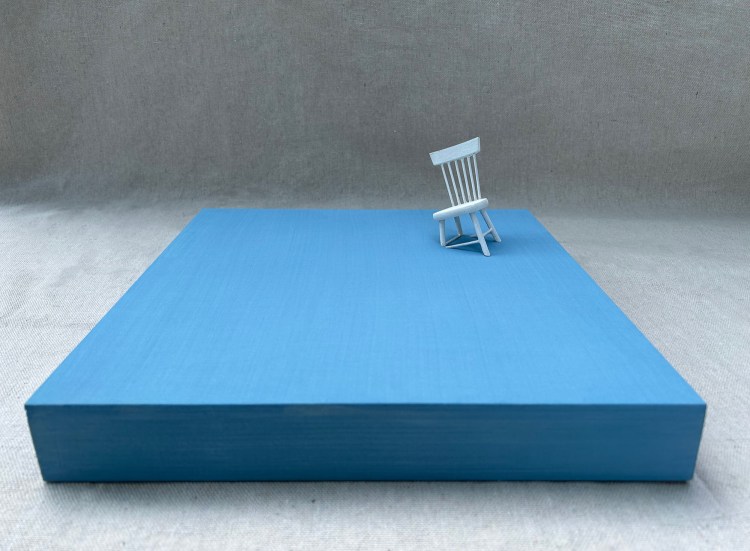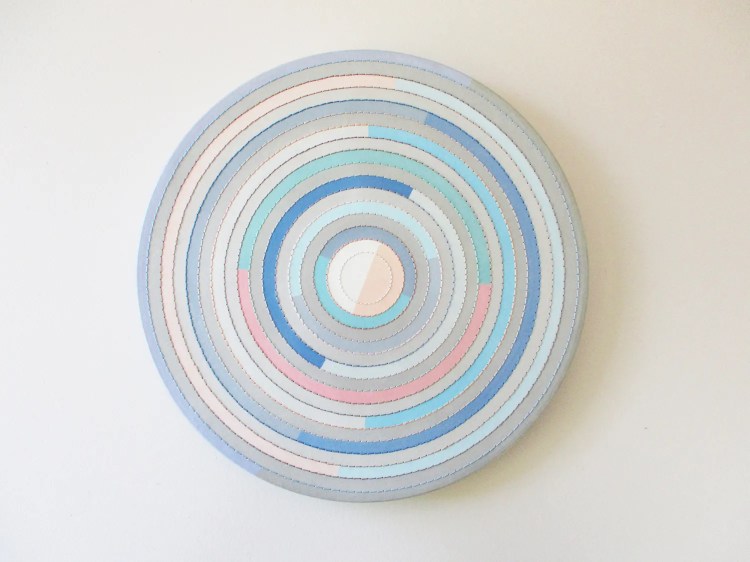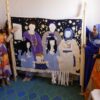
Ling-Wen Tsai, “Rising/Sinking Study Chair,” wood and milk paint, 12 x 12 x 5 inches. Photo courtesy of Corey Daniels Gallery and Life Forms
One of the great pleasures of visiting Corey Daniels Gallery in Wells is always the hunt. The rambling spaces are chock-full of interesting art, objects and intriguing juxtapositions of these that one just happens upon by accident. The current hunt Daniels offers us is “Life Forms” (through Sept. 21), the debut show of a new women’s sculpture collective of the same name.
The idea for the collective was hatched a year ago by Leah Gauthier and Bronwen O’Wril, a fellow artist mom who Gauthier met at a summer camp she runs for children. It was largely a response to the isolation of the pandemic, which fomented in both women a deep desire for community. Gauthier and O’Wril assembled a list of artists they admired, and the dozen who now form the collective began meeting over Zoom to plan not one but several shows. Five are in the works, with confirmed stops at Speedwell Gallery in November (all 12 artists), University of Southern Maine (focusing on four of the sculptors) and a yet-to-be-announced final venue that’s just been “penciled in” for 2027.
For this show, many of the women pulled from existing work, though in the future there will be more of a conversation among new work they will make that will be influenced by the women’s creative interactions. So, it is fitting that Daniels should be the first stop, as their very individual visions lend themselves to singular, rather than group, viewing.
Besides Gauthier and O’Wril, the collective is made up of Jackie Brown, Lynn Duryea, Kazumi Hoshino, Elaine K. Ng, Ashley Page, Veronica Perez, Celeste Roberge, Naomi David Russo, Ling-Wen Tsai and Erin Woodbrey. It’s impossible to cover everyone, even though the work is uniformly interesting. Each artist presents two works.
I was immediately drawn to Woodbrey’s “Surface Cleaner” and, especially, “Waters,” for which, like “Surface Cleaner,” she covered single-use containers – bottles of bleach, gallon jugs of spring water or milk, etc. – with gauze and a slurry of ash and plaster. These she accommodates on repurposed upside-down tomato cages.

Erin Woodbrey, “Waters (From The Carrier Bag Series),” single-use containers, ash, plaster, gauze, wire, 55 x 10 x 13 inches. Photo courtesy of Corey Daniels Gallery and Life Forms
Both works have an interesting sense of visual volume and porosity, and call attention to many things: among them, the idea of plastics as part of a cycle of human consumption and waste and, of course, their destiny as pollutants. More broadly, however, they may refer to the ephemerality of all that is man-made, its lasting effects on our condition of being, and the way nature responds to and, in some ways, outlives human presence. The gauze-ash-plaster shell called to mind objects of shipwrecks buried at immense depths beneath the ocean or occasionally poking out of riverbeds, which are covered in silt and/or encrustations of coral and other marine life.
The consequences of their noxious contents are, at this point, faits accomplis. But the containers themselves – and concepts of containment and holding – have been embalmed in some way by nature to protect itself by sealing them away from further damage. Microplastics, of course, have now officially been found in the fossil record. But nature can be powerful in the face of human onslaught, proving, in the end, the undeniable and innate vulnerability of human existence. “Waters” adds another contemplation: the effects of action and inertia on the state of liquids (or our bodies or our very being) when standing, resting on their sides or pouring.
Ashley Page’s work is also about containers and holding. Ostensibly, her sculptures consist of basket shapes. But in a larger sense, they are metaphors for the body and the spirit, both vessels for identity, personal narratives and experience. The title “Black and Porous” is a statement about the physical form of one sculpture. But it can also be read as a container for the ever-evolving Black experience, which defies monolithic categorization and, instead, represents a panoply of manifestations and consciousness.

Ashley Page, “Black Seeds,” wire, handmade abaca paper, woodstain. Photo courtesy of Corey Daniels Gallery and Life Forms
“Black Seeds” is a touching, tender evocation of holding. The three larger shapes recall seed pods, along with all their associations of nascence, growth and maturation. The largest form, however, nestles two smaller ones inside it, also suggesting a papoose or a womb and, by extension, a continuum of generations and evolution.
Veronica Perez also explores cultural origin and its inherent sense of bonding. Her works, like “Suspensión” here, are constructed from synthetic hair in “braiding circles,” so they are physical embodiments of communal memory and identity. As in Page’s work, the amorphous nature of the forms that result, and the intertwining physicality of their braiding, also intimate the ever-changing experience of heritage and identity, as well as the impact of the world (here the European white world) on that identity through colonialism, theft of native lands, displacement and so on.

Veronica Perez, “Suspensión,” artificial hair, wood, burlap, 36 x 48 x 12 inches. Image by Jo Silver
Here, Perez cradles her large, braided form in muslin straps suspended from a wooden frame. The allusions here could be many: It might be an injured or abused body in a stretcher-like support, a tender holding structure for her experience or, as the title indicates, some intermittent state between realities (of separateness and integration, inside and outside, exposure and protection, and other possibilities).
Roberge’s work has long been about the environment, specifically about the crisis of rising sea levels in response to global warming. “Seaweed Will Be Lapping at Your Doorstep #2” points to the adaptability and resilience of seaweed and consists of seaweed and wax layered over her own rubber boots. “Long Seaweed Boat” is a bronze sculpture of seaweed that has been formed into a boat shape.

Celeste Roberge, “Long Seaweed Boat,” bronze cast from one blade of kelp, 7.25 x 29 x 6 inches. Photo courtesy of Corey Daniels Gallery and Life Forms
Both sculptures are different forms of what Roberge calls “survival gear” – different means by which we might wade through and/or escape the degradation of our oceans. The boots (this series also includes garments like a wet suit and a fisherman’s sweater) are impactful but more literal-minded. Roberge’s boat, which was part of a larger exhibit last year called “Women of the Gulf” that included many female sculptures formed out of seaweed and cast in bronze, has a moving sort of grace and elegance that transcends the specific issue it references.
Ling-Wen Tsai’s two works – “Rising/Sinking” studies of a chair and a bench – are the only works in the show that I wish had been given more space around them. I also wish they were on higher pedestals. The reason is they are very quiet, intimate works, and you want to get up close to them.
Basically, they consist of a blue plinth into or out of which the said furniture is sinking or emerging. These are very unlike anything this artist has done before, though we could draw a connection in the concept of things manifesting or receding back into non-manifestation. The blue may also indicate rising and falling sea levels and, indeed, her artist statement talks, in part, about her “interest in the relationship and tension between the human and non-human world, and how they influence and impact one another.”

Leah Gauthier, “Partly Cloudy,” acrylic, gouache and silk thread on linen, 18 x 18 inches. Photo courtesy of Corey Daniels Gallery and Life Forms
But for me, the quietness of the work stems from the sense of immersion in or emergence from states of being. There is something profoundly still about the blue plinth. It feels like a kind of void to nothingness, where there is literally no existence – of objects, concepts, forms, even states of mind. In that sense, it telegraphs an excruciatingly beautiful peacefulness, so much so that we want to sink into it and leave all worldly possessions and cares behind. The minuteness of the chair and bench further evokes the insignificance not only of the man-made, but human existence itself. They feel completely temporary and resting on anything but solid ground.
There are a lot of ideas here. The exquisitely constructed circular silk paintings of Gauthier, which are like color studies and/or charts of the sky on “Partly Cloudy” and “Mostly Sunny” days. The geological or treelike forms of Brown’s 3D-printed ceramic forms. The harmonizing of disparate stone textures that happens in Hoshino’s work. The perfect glazes of Lynn Duryea’s sculptures, which speak of erosion, decay and the passing of time. It’s a rewarding hunt in every way.
This post was originally published on this site be sure to check out more of their content







